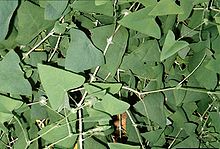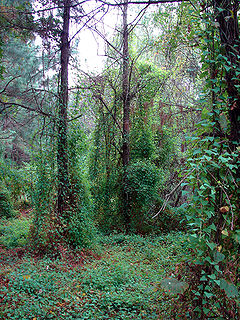- Persicaria perfoliata
-
Mile-a-minute weed 
Scientific classification Kingdom: Plantae (unranked): Angiosperms (unranked): Eudicots (unranked): Core eudicots Order: Caryophyllales Family: Polygonaceae Genus: Persicaria Species: P. perfoliata Binomial name Persicaria perfoliata
(L.) H. GrossMile-a-minute weed (Persicaria perfoliata, formerly Polygonum perfoliatum), also known as Devil's tail, tearthumb, Asiatic tearthumb, Gangbangui, or Devil Shield, is an herbaceous annual, trailing vine in the buckwheat family, Polygonaceae. It has barbed stems and leaves and triangular leaves. It is native to most of eastern Asia (both tropical and temperate).[1]
It has a reddish stem that is armed with downward pointing hooks or barbs which are also present on the underside of the leaf blades. The light green colored leaves are shaped like an equilateral (equal-sided) triangle and alternate along the narrow, delicate stems. Distinctive circular, cup-shaped leafy structures, called ocreas, surround the stem at intervals. Flower buds, and later flowers and fruits, emerge from within the ocreas. Flowers are small, white and generally inconspicuous. The fruits are attractive, metallic blue and segmented, each segment containing a single glossy, black or reddish-black seed.
Mile-a-minute weed generally colonizes open and warm areas, along the edges of woods, wetlands, stream banks, and roadsides, and uncultivated open fields, resulting from both natural and human causes, dense wooded areas where the overstory has opened up increasing the sunlight to the forest floor. Natural areas such as stream banks, parks, open space, road shoulders, forest edges and fence lines are all typical areas to find mile-a-minute. It also occurs in environments that are extremely wet with poor soil structure. Available light and soil moisture are both integral to the successful colonization of this species. It will tolerate shade for a part of the day, but needs a good percentage, 63-100% of the available light. The ability of mile-a-minute to attach to other plants with its recurved barbs and climb over the plants to reach an area of high light intensity is a key to its survival. It can survive in areas with relatively low soil moisture, but demonstrates a preference for high soil moisture.
 Mile-a-minute weed is a very invasive species.
Mile-a-minute weed is a very invasive species.
The first records of mile-a-minute in North America are from Portland, Oregon (1890) and Beltsville, Maryland (1937). Both of these sites were eliminated or did not establish permanent populations of the species. However, the introduction of mile-a-minute somewhere between the late 1930s and 1946 to a nursery site in Stewartstown, York County, Pennsylvania did produce a successful population of this plant. It is speculated that the seed was spread with Rhododendron stock. The owner of the nursery was interested in the plant and allowed it to reproduce; subsequent efforts to eradicate it were not successful. The distribution of mile-a-minute has radiated from the York County site into neighboring states. 55 years after its introduction, the range for this plant in the United States had extended as far as 300 miles (480 km) in several directions from the York County, Pennsylvania site.
Mile-a-minute weed is primarily a self-pollinating plant (supported by its inconspicuous, closed flowers and lack of a detectable scent), with occasional outcrossing. Fruits and viable seeds are produced without assistance from pollinators. Vegetative propagation from roots has not been successful for this plant. It is a very tender annual, withering with a slight frost, and reproduces successfully until the first frost. Mile-a-minute is a prolific seeder, producing many seeds on a single plant over a long season, from June until October in Virginia, and a slightly shorter season in more northern geographic areas.
Birds are probably the primary long-distance dispersal agents of mile-a-minute weed. Transport of seeds short distances by native ant species has been observed. This activity is probably encouraged by the presence of a tiny white food body (elaiosome) on the tip of the seed that may be attractive to the ants. These seed-carrying ants may play an important role in the survival and germination of the seeds of mile-a-minute weed. Local bird populations are important for dispersal under utility lines, bird feeders, fence lines and other perching locations. Other animals observed eating mile-a-minute weed fruits are chipmunks, squirrel and deer.
Water is also an important mode of dispersal for mile-a-minute weed. Its fruits can remain buoyant for 7-9 days, an important advantage for dispersing seed long distances in stream and river environments. The long vines frequently hang over waterways, allowing fruits that detach to be carried away in the water current. During storm events the potential spread of this plant is greatly increased throughout watersheds.
Uses
In traditional Chinese medicine, mile-a-minute weed is known as gangbangui (Chinese: 杠板归; pinyin: gāngbǎngūi), and is valued for its diuretic, anti-inflammatory, and other effects. It may also be eaten as a sour-flavored leaf vegetable, although its relatively high content of oxalic acid means that it should be eaten in moderation, and avoided by people with kidney disorders, gout, or rheumatoid arthritis.
References
- ^ Persicaria perfoliata (L.) H. Gross, GRIN Taxonomy for Plants
- http://www.nps.gov/plants/alien/pubs/midatlantic/pope.htm
- http://ohioline.osu.edu/b866/b866_10.html
- http://www.invasivespeciesinfo.gov/plants/mileminute.shtml
- http://www.itis.gov/servlet/SingleRpt/SingleRpt?search_topic=TSN&search_value=20914
- http://www.invasive.org/eastern/biocontrol/26MileAMinute.html
- http://www.fs.fed.us/database/feis/plants/vine/polpef/all.html
External links
 Media related to Persicaria perfoliata at Wikimedia Commons
Media related to Persicaria perfoliata at Wikimedia Commons  Data related to Persicaria perfoliata at Wikispecies
Data related to Persicaria perfoliata at Wikispecies- USDA invasive species
- Species Profile- Mile-A-Minute Weed (Persicaria perfoliata), National Invasive Species Information Center, United States National Agricultural Library. Lists general information and resources for Mile-A-Minute Weed.
- US Forest Service Pest Alert flyer
- US Forest Service FEIS database entry
Categories:- Persicaria
- Leaf vegetables
- Invasive plant species
- Invasive plant species in the United States
- Plants described in 1759
Wikimedia Foundation. 2010.
